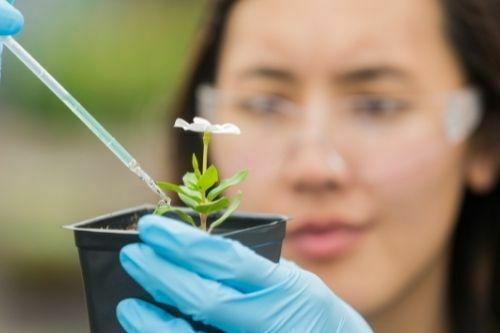Table of Contents
An MSc Botany is a two-year PG degree program that aims to delve further into the difficult issues of plant biology. This course covers a wide range of plant, fungal, and algae-related subjects, such as growth, structure, features, and biochemical processes. The MSc Botany program combines academic and practical components, such as laboratory work and workshops, and encourages students to do research in this field.
Students pursuing an MSc in Botany may be able to find work in the public health service, agriculture department, forest service, conservation departments, and land management. They can work in the private sector for food companies, seed companies, plant biotechnology firms, and agriculture product companies.
Major subjects covered in the MSc Botany syllabus

Syllabus
MSc Botany Syllabus comprises mostly core and optional subjects that cover a wide range of topics in this large scientific area. Though the curriculum for this degree may differ from one university to the next, we have included some of the important MSc Botany subjects below.
- Phycology, sometimes known as Algology, is a subdiscipline of Botany that focuses on the study of algae. Algae are essential primary producers in aquatic ecology. When you study Phycology as part of the MSc Botany curriculum, you will learn about the various types of algal creatures, such as eukaryotic, prokaryotic, and photosynthetic algae, and their significance in ecology.
- Microbiology is a distinct subdiscipline included in the MSc Botany curriculum. Bacteria, protozoa, viruses, archaea, and fungus are examples of tiny creatures studied. You will learn about the physiology, ecology, cell biology, evolution, and clinical aspects of microorganisms, as well as the host response to these agents, in Microbiology.
Plant Anatomy and Developmental Biology
Plant Anatomy is the study of the detailed anatomy of plants, which includes the leaf, stem, roots, flowers, and fruits, whereas Development Biology is concerned with how multicellular plants evolve from a single zygotic cell. This sub-discipline primarily examines how a plant develops and how different biological processes to aid in its growth.
Bryophyta is the most basic class, with a dependent flagellated sperm and sporophyte that may be fertilized and is dependent on an external water medium.
A pteridophyte is a type of vascular plant that spreads spores. Because pteridophytes do not produce flowers or seeds, they are frequently referred to as “cryptogams,” which suggests that their mode of reproduction is concealed. Pteridophytes include ferns, horsetails, and lycophytes.
Unlike angiosperms, gymnosperms have ovules that are not encased within the ovary wall. It is exposed before, during, and after fertilization, as well as before growing into a seed. Gymnosperm stems can be branched or unbranched. These plants’ thick cuticle, needle-like leaves, and recessed stomata limit the rate of water loss.

Mycology and Plant Pathology
Pathology is the study of plant diseases. Mycology and Plant Pathology are complementary parts of the MSc Botany curriculum since one concentrates on the structural and behavioral characteristics of fungus and the other on the many traits, reasons, and causes of plant illnesses, as well as techniques of managing and treating plant diseases.
Mycology
Is the area of biology that studies fungus, including its genetic and biochemical features, taxonomy, and human applications, such as tinder, traditional medicine, food, and entheogens, as well as their risks, such as toxicity or infection.
Plant pathology
Is the study of the causes of plant diseases, the mechanisms by which illnesses occur in individual plants and plant populations, and the methods and techniques by which plant diseases may be treated or controlled.
Paleobotany and Palynolog
Paleobotany is the scientific study of prehistoric plants via the use of plant fossils discovered in sedimentary rocks. These fossils might be imprints or compressions of plants left on the rock’s surface, or they can be “petrified” materials, such as wood, that preserve the original plant material in rocklike form.
Palynology is the scientific study of pollen grains and spores that are often found in geological and archaeological deposits. Palynology is an interdisciplinary science that combines earth science (geology or geological research) and biological science (biology), specifically plant science (botany). Stratigraphic palynology, a subfield of micropalaeontology and paleobotany, investigates fossil palynomorphs from the Precambrian through the Holocene epochs.
Phytochemistry and Pharmacognosy
Phytochemistry is a branch of botany and chemistry. It is the study of compounds originating from plants, commonly known as phytochemicals. Plants use phytochemicals to protect themselves from insect assaults and illnesses.
Pharmacognosy, on the other hand, is a related discipline of Phytochemistry that is concerned with the study of plants or other natural sources that may be utilized as a source of pharmaceuticals and remedies. Pharmacognosy is defined as “the study of the physical, chemical, biochemical, and biological characteristics of medications, drug substances, or potential drugs or drug substances of natural origin, as well as the search for novel drugs from natural sources” by the American Society of Pharmacognosy.
Microbial Biotechnology: Microbial Biotechnology or Industrial Microbiology refers to the utilization of microorganisms (such as bacteria, fungus, algae, protozoa, and viruses) to produce an economically valuable product or activity on a commercial or industrial scale.
Examples include the creation of large-scale procedures for the manufacture of citric acid, amino acids, and antibiotics, as well as better biotransformation of steroid hormones and the mass manufacturing of various enzymes.
Computer Applications and Bioinformatics: Bioinformatics applications are related to the use of mathematics, biology, computer science, and statistics to represent and analyze biological data. Bioinformatics is the development of biological software and methods enabling computers to capture and analyze biological data.
Top universities for MSc Botany
The table below lists Postgraduate Botany Courses abroad at top-ranked universities-
| University | Name of the Specialization |
| Claremont Graduate University, USA | MSc in Botany |
| The University of Essex, UK | MPhil in Plant Biology |
| The University of Hawaii – Manao | Masters of Science in Botany |
| University of Edinburgh, UK | MSc – Drug Discovery and Translational Biology |
| University of Kent, UK | Ethnobotany – MSc |
| University of British Columbia, Canada | Masters of Science in Botany |
| University of Wisconsin – Madison | MSc in Botany |
| Queen Mary University of London | MSc Plant & Fundal Taxonomy Diversity and Conservation |
| University of Maine, USA | Masters of Science in Botany & Plant Pathology |
MSc Botany scope

Botany as a vocation offers a variety of work opportunities. It is determined by criteria such as the candidate’s educational qualification, interest, pay structure, and job location. A botanist can work in one of the following positions:
Ecologist
An ecologist investigates environmental risks to plants and trees and strives to manage climate and safeguard plant species. It performs scientific research, categorizing plants and other species, and so forth. An ecologist plans habitat management or environmental restoration projects, including procedures, resources, schedules, and budgets, based on the information gathered.
Florist
The florist is in charge of handling flower shipments, trimming flowers at regular intervals, and creating marketable bouquets. He is also a florist, selling flowers and plants in the form of bouquets and wreaths.
Taxonomist
Taxonomy is the practice of classifying plants based on their morphological and biological features. A taxonomist is someone who identifies and categorizes plant species. A taxonomist decides how to classify them, studies how they fit into their ecosystems and classifies their interactions with other species.
Agriculturalist
An agriculturalist creates and grows disease-resistant crops for human consumption, as well as pest and weed management solutions for agriculture. He has mostly received training in the agricultural specialty, animal specialization, farm management specialization, and biotechnology specialization.
Researcher
The researcher works in laboratories, where he or she conducts studies on various plant species.
Liked this blog? Read next: Top 10 BSc course options every student should know about
Key Takeaways
- The M.Sc in Botany postgraduate degree program provides graduates with outstanding employment chances in the private and public sectors of several recognized businesses worldwide.
- Jobs and compensation for the M.Sc in Botany degree are diversified, with excellent placements for postgraduates after the degree.
- The M.Sc Botany program provides students with all of the necessary knowledge to excel in their chosen careers.
Liked this blog? Read next: Top 10 BSc course options every student should know about
We hope you enjoyed reading this blog post. If you have any doubts, you can reach us here.
You can also leave a comment below and share your thoughts.
FAQs
Q1. Is botany a viable career path?
Answer- Botany is an excellent career choice for those interested in plant life. They can work in plant analysis, research, and environmental studies, among other things.
Q2. What are the ideal jobs after MSC botany?
Answer- After earning your MSc in botany, you will be able to work in the public and government sectors. Plant Taxonomy, Weed Scientists, Ethnobiology, Plant Scientists, Pathology, Palynology, Plant Ecology, and many other MSc botany jobs.
Q3. What is the average salary for a Botanist?
Answer- The average Botanist remuneration in the United States is $70,791, with a salary range of $58,472 to $87,374. Salary ranges can vary greatly depending on a variety of things, including schooling, certifications, additional expertise, and the number of years you have worked in your field.






